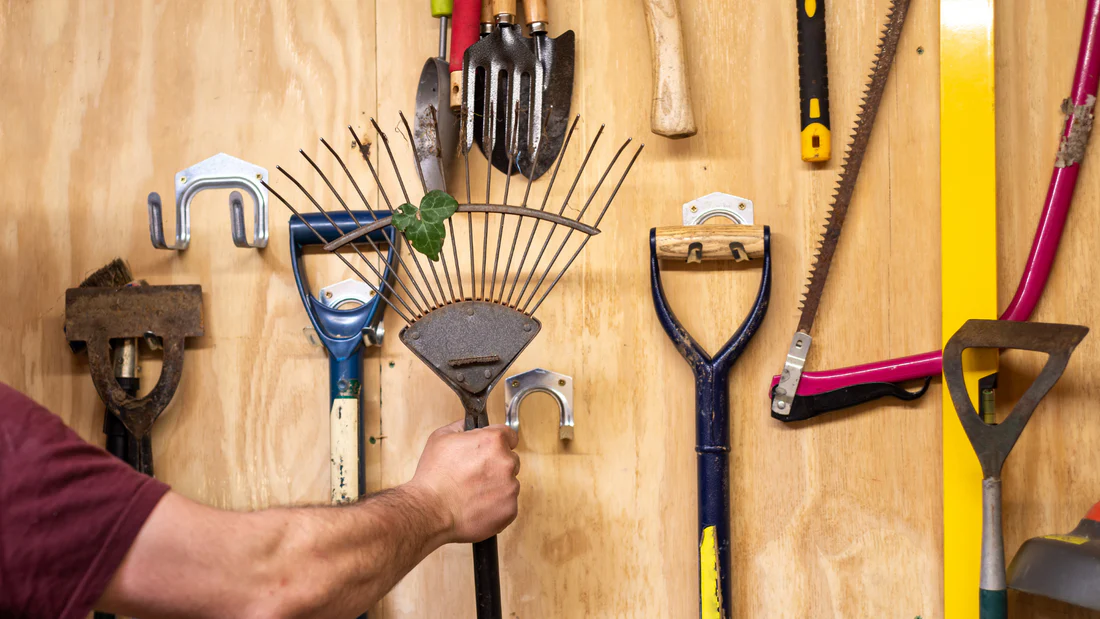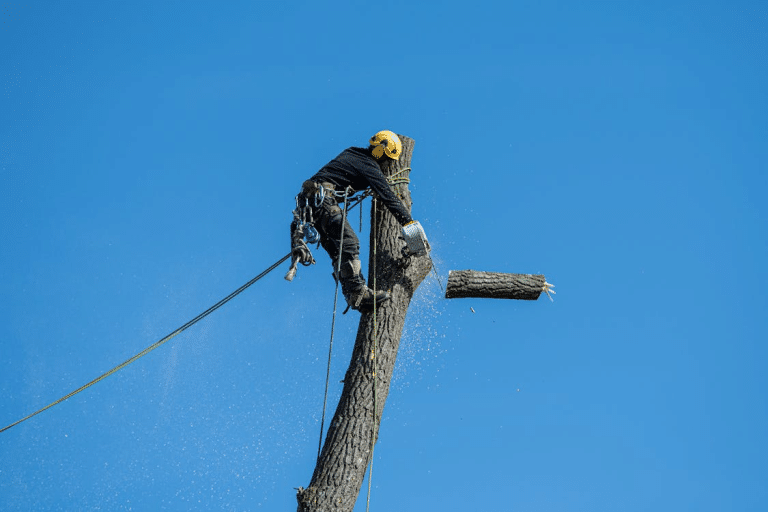Gardening isn’t merely a fulfilling hobby – it can also mean juggling all sorts of tools, from trowels and pruners to wheelbarrows and electric trimmers. Storing these tools properly really matters. It keeps you safe, helps everything last longer, and just makes your gardening routine easier. Let’s learn the right way to store gardening tools, which can help avoid injuries and cut down on replacement costs.
Proper Tool Storage Matters
Keeping your tools safely actually helps protect what you’ve invested in and keeps everyone a bit safer. If you leave sharp tools lying around, it’s easy for a pet, a kid, or even yourself to get hurt. And if you’re not careful about how you store things, rust can make your pruners worthless, or turn that shovel into something likely to snap when you need it most.
But take the time to store everything properly, and your tools will last way longer; they’ll be better protected from moisture, sunlight, and even pests. Plus, having everything in its spot really does save time. You can dive right into gardening without hunting for lost gear or getting sidetracked by a messy pile of spades. It just makes the whole process smoother – and a lot more enjoyable.
Having a well-organized storage setup really makes things run smoother. Take a metal workbench with drawers and cabinets, for instance: you can toss your go-to hand tools, seed packets, gloves – whatever you reach for a lot – into the right spot and actually find them later. Not only does this keep your tools protected, but you also get a sturdy surface for potting plants or tinkering with small repairs.
How to Choose the Right Storage Location
Before you start organizing your tools, figure out where you’ll actually keep them. The best spot? Somewhere clean, dry, easy to get to, and with plenty of airflow.
- Sheds and garages. These work well because they keep tools out of the weather, and they usually have space for everything from tiny screwdrivers to bulky power saws. Just make sure the building is watertight and has decent ventilation – otherwise, you could end up with mold or rusty tools.
- Basements and utility rooms. No shed or garage? A basement or utility room can do the job for smaller tools. The thing to watch out for is moisture, especially in older houses. Humidity can sneak up on you and may cause problems if you’re not careful.
|
Storage Option |
Pros |
Cons |
|---|---|---|
|
Garden Shed |
Dedicated space, good ventilation |
May require extra insulation |
|
Garage |
Spacious, multi-functional |
Shared space with other equipment |
|
Basement |
Indoor, climate-controlled |
Potential moisture problems |
|
Utility Closet |
Easy access |
Limited space |
Organizing Tools by Type and Use
Once you’ve figured out where to keep your tools, grouping them by type makes everything easier to grab (and keeps things safer, too).
- Hand tools: Trowels, pruners, shears, even gloves – all that smaller stuff – work well in a labeled toolbox or hanging up on a pegboard. If a tool has a blade, make sure it’s covered so you don’t wind up with any unexpected cuts. You can always use a magnetic strip or a slotted rack to keep things locked in place, too.
- Long-handled tools: Shovels, rakes, hoes, and brooms are easier to deal with if you hang them vertically on hooks or brackets. This keeps them off the ground and stops the handles from warping over time. Horizontal storage works fine as well. Just make sure they’re secured so nothing comes crashing down.
- Power tools: For things like trimmers, leaf blowers, and chainsaws, it’s best to stash them in their original cases (if you still have them). Remove any batteries and give the tools a quick clean before putting them away. And don’t forget: keep power tools well out of reach of kids and far from anything flammable.
Cleaning and Preparing Tools for Storage
If you keep your gardening tools clean, they’ll last longer and work better – plus, you’ll avoid rust and nasty bacteria. Dirt, sap, and leftover moisture do the opposite, causing tools to break down over time. That’s why it’s smart to give them a quick clean before you put them away.
Here’s how to clean your tools:
- First, get rid of soil and gunk with a stiff brush or a cloth.
- Sanitize the blades now and then – especially after cutting diseased plants – using a mix of one part bleach to nine parts water, or just use some rubbing alcohol.
- Dry everything completely so rust doesn’t have a chance to form.
- Wipe down metal parts with linseed oil or a little machine oil to keep them sharp and smooth.
- Take a quick look for any damage and make repairs before you store the tools away.
Honestly, even five minutes of cleaning and maintenance can add years to a tool’s life – and it’ll help keep you safe, too.
Storage Solutions That Enhance Safety
A smart storage setup cuts down on mess, lowers the risk of accidents, and just makes things run smoother.
- Wall-mounted systems. Pegboards or slat walls are easy to customize and can handle just about anything-hand tools, hoses, you name it. Set up some labeled hooks or bins to keep similar items together. Simple, but it works.
- Freestanding racks. Tool towers and corner racks fit those long-handled tools perfectly. They keep everything standing up and easy to spot, so you’re less likely to trip over a stray shovel.
- Lockable cabinets and boxes. When you’ve got fertilizers, pesticides, or anything chemical-based, lock them up – never store those next to your regular tools. And sharp stuff? Keep that in lockable units, too, especially if kids are around.
- Buckets and bins. Gloves, plant ties, small labels – all that little stuff piles up fast. Toss them in labeled bins, and if you can stack the bins, even better. Keeps everything neat and within reach.
Seasonal Storage Tips
Different seasons mean you’ll need to tweak how you store your garden gear. Once gardening winds down – usually in late fall – it’s worth taking a moment to stash your tools properly for winter.
- Drain and coil your garden hoses so they won’t freeze up or crack.
- Battery-powered tools? Keep them inside, somewhere that stays around room temperature.
- If you have gas-powered gear, empty out the fuel before storing.
- Delicate stuff like clay pots or fancy accessories should come inside, too, so they don’t crack from the cold.
- And hang your tools up – don’t just leave them sitting on the garage floor, where melting snow or condensation can create problems.
Come spring, it’s smart to do a little reorganization. Check tools for rust and wear, sharpen up any blades, and make sure you restock basics like twine and gloves before things get busy again.
Safety Precautions to Keep in Mind
Keeping your tools organized is important, but making your storage space safe matters just as much. Label shelves and bins so you don’t end up grabbing the wrong thing (or putting stuff where it doesn’t belong). Good lighting helps too – nobody likes searching for tools in the dark or reaching into unknown corners.
Make sure heavy items are stowed securely so they won’t topple if you brush past them. Store chemicals away from tools and seeds; this keeps everything cleaner and avoids any messy cross-contamination. If you have kids around, teach them basic safety rules and keep anything sharp or powered well out of their reach.
Set up your storage area with safety as the priority, and you’ll avoid injuries – and honestly, your garden will just be a nicer, easier spot to work in.
Final Thoughts
Keeping your gardening tools stored safely isn’t complicated, but it makes a big difference. It protects your gear and helps it last longer, plus it keeps your workspace from turning into a tripping hazard. Clean your tools, stay organized, and put a little thought into where you store things – even a tiny shed can turn into a seriously efficient (and much safer) spot. Start with simple steps and keep up the habit. Before long, you’ll realize that caring for your tools is just as important as tending the garden itself.














